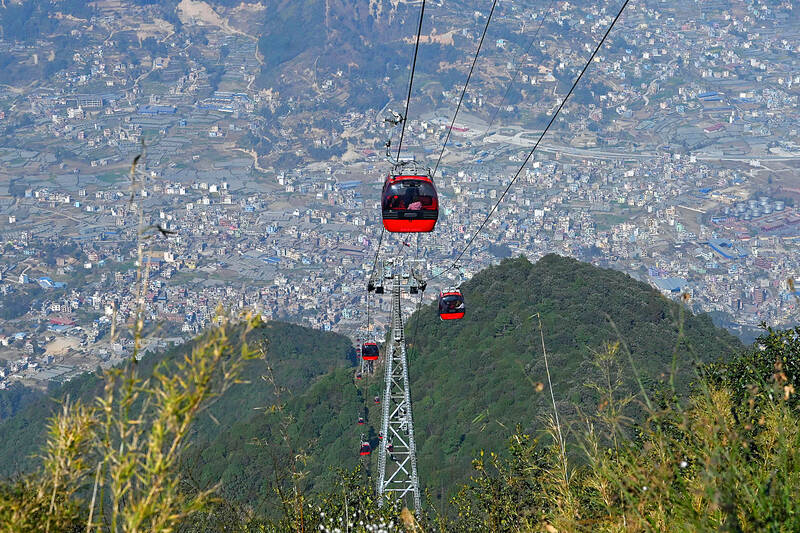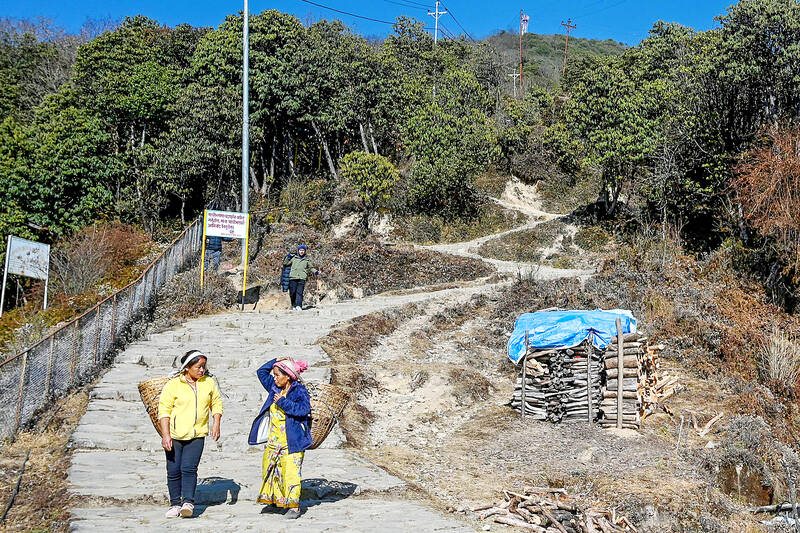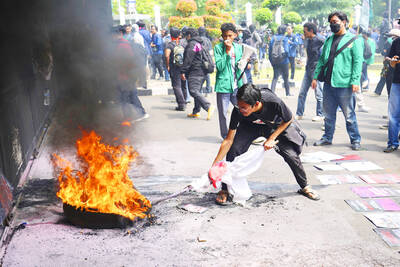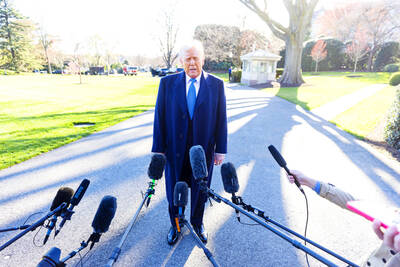They appear tranquil soaring above Himalayan forests, but a string of cable car projects in Nepal have sparked violent protests, with locals saying environmental protection should trump tourism development.
In Nepal’s eastern district of Taplejung, the community has been torn apart by a US$22 million government-backed project many say would destroy livelihoods and damage ancient forests they hold as sacred.
Across Nepal, five cable car projects have opened in the past two years — and 10 more are under development, according to government data.

Photo: AFP
Critics accuse the government of failing to assess the environmental impact properly.
Protests in Taplejung last month escalated into battles with armed police, with four activists wounded by gunfire and 21 police officers injured.
The protests calmed after promises construction would be suspended, but erupted again this week, with 14 people wounded on Thursday — 11 of them members of the security forces.

Photo: AFP
“We were in a peaceful protest, but hired thugs showed us kukris [large knives] and attacked us — and we countered them,” protest committee leader Shree Linkhim Limbu said after the latest clashes.
He vowed to continue demonstrations until the project is scrapped.
About 300,000 Hindu devotees trek for hours to Taplejung’s mountaintop Pathibhara temple every year — a site also deeply sacred to the local Limbu people’s separate beliefs.
Chandra Prasad Dhakal, a businessman with powerful political ties who is also president of Nepal’s Chamber of Commerce and Industry, in 2018 announced the construction of a 2.5km cable car to the temple.
The government calls it a project of “national pride.”
Dhakal’s IME Group is also building other cable cars, including the 6.4km Sikles line in the Annapurna Conservation Area, which the Nepalese Supreme Court upheld.
The government deemed the project a “national priority,” thereby exempting it from strict planning restrictions in protected areas.
The Supreme Court scrapped that controversial exemption last month, a move celebrated by environmentalists, but activists fear the project could still go ahead.
Taplejung is deeply sacred to local Mukkumlung beliefs, and residents say that the clearance of about 3,000 rhododendron trees — with 10,000 more on the chopping block — to build pylons is an attack on their religion.
“It is a brutal act,” Limbu said. “How can this be a national pride project when the state is only serving business interests?”
Saroj Kangliba Yakthung, 26, said locals would rather efforts and funding were directed to “preserve the religious, cultural and ecological importance” of the forests.
The wider forests are home to endangered species, including the red panda, black bear and snow leopard.
“We worship trees, stone and all living beings, but they are butchering our faith,” said Anil Subba, director of the Kathmandu-based play Mukkumlung, which was staged for a month as part of the protest.
The hundreds of porters and dozens of tea stall workers that support trekking pilgrims fear for their livelihoods.
“If they fly over us in a cable car, how will we survive?” 38-year-old porter Chandra Tamang asked.
The government says the cable car would encourage more pilgrims by making it easy to visit, boosting the wider economy in a nation where unemployment hovers at about 10 percent and GDP per capita is just US$1,377, according to the World Bank.
“This will bring development,” said resident Kamala Devi Thapa, 45, adding that the new cable car route would aid “elderly pilgrims.”
The cable cars symbolize Nepal’s breakneck bid to cash in on tourism, making up more than 6 percent of the nation’s GDP in 2023, according to the World Travel and Tourism Council.
Beyond the Pathibhara project, the government’s environmental policy is in question — in a nation that is 45 percent forest.
More than 255,000 trees have been cut down for infrastructure projects in the past four years, according to the Nepalese Ministry of Forests and Environment.
“Nepal has witnessed massive deforestation in the name of infrastructure,” said Rajesh Rai, professor of forestry at Tribhuvan University. “This will have severe long-term consequences.”
Unperturbed, the cable car builder assures his project would create 1,000 jobs and brushes aside criticism.
“It won’t disturb the ecology or local culture,” Dhakal said. “If people can fly there in helicopters, why not a cable car?”
The argument leaves Kendra Singh Limbu, 79, unmoved.
“We are fighting to save our heritage,” he said.
It has split the community, local journalist Anand Gautam said.
“It has turned fathers and sons against each other,” Gautam said. “Some see it as progress, others as destruction.”

The head of Shin Bet, Israel’s domestic intelligence agency, was sacked yesterday, days after Israeli Prime Minister Benjamin Netanyahu said he no longer trusts him, and fallout from a report on the Oct. 7, 2023, Hamas attack. “The Government unanimously approved Prime Minister Benjamin Netanyahu’s proposal to end ISA Director Ronen Bar’s term of office,” a statement said. He is to leave his post when his successor is appointed by April 10 at the latest, the statement said. Netanyahu on Sunday cited an “ongoing lack of trust” as the reason for moving to dismiss Bar, who joined the agency in 1993. Bar, meant to

Indonesia’s parliament yesterday amended a law to allow members of the military to hold more government roles, despite criticisms that it would expand the armed forces’ role in civilian affairs. The revision to the armed forces law, pushed mainly by Indonesian President Prabowo Subianto’s coalition, was aimed at expanding the military’s role beyond defense in a country long influenced by its armed forces. The amendment has sparked fears of a return to the era of former Indonesian president Suharto, who ex-general Prabowo once served and who used military figures to crack down on dissent. “Now it’s the time for us to ask the

The central Dutch city of Utrecht has installed a “fish doorbell” on a river lock that lets viewers of an online livestream alert authorities to fish being held up as they make their springtime migration to shallow spawning grounds. The idea is simple: An underwater camera at Utrecht’s Weerdsluis lock sends live footage to a Web site. When somebody watching the site sees a fish, they can click a button that sends a screenshot to organizers. When they see enough fish, they alert a water worker who opens the lock to let the fish swim through. Now in its fifth year, the

‘INCREDIBLY TROUBLESOME’: Hours after a judge questioned the legality of invoking a wartime power to deport immigrants, the president denied signing the proclamation The US on Friday said it was terminating the legal status of hundreds of thousands of immigrants, giving them weeks to leave the country. US President Donald Trump has pledged to carry out the largest deportation campaign in US history and curb immigration, mainly from Latin American nations. The order affects about 532,000 Cubans, Haitians, Nicaraguans and Venezuelans who came to the US under a scheme launched in October 2022 by Trump’s predecessor, Joe Biden, and expanded in January the following year. They would lose their legal protection 30 days after the US Department of Homeland Security’s order is published in the Federal